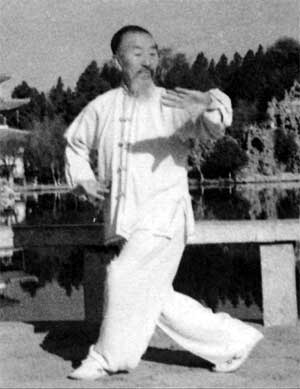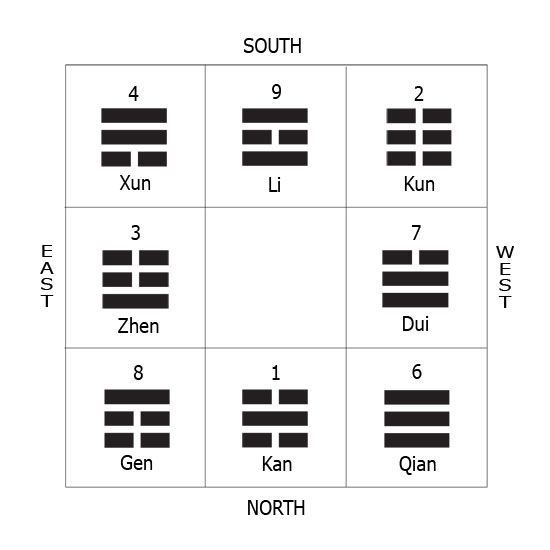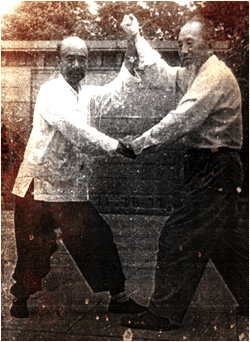
"Eight Diagrams" (bagua) are one of the most important discoveries of ancient Chinese civilization and is a global compilation of the laws of the objective world, including the "sky, the earth," and man, modeling patterns of changes characteristic of all things in the universe. And as evidenced by the practice of several tyasyachelety, many scientists, both in China and abroad, have made many discoveries, based on profound scientific principles contained in this doctrine. In traditional Chinese medicine, for example, used the doctrine of yin and yang and the "Five Elements" (Wu Xing), classified in accordance with the principles of "Eight Diagrams", starting from the image of trigrams, Leibniz developed the binary system, Einstein created the theory of relativity also under influenced by the teachings of the "Eight Diagrams", Liu Tszyhua in his book "The Space trigrams - the hypothesis of a new planet" made a prediction about the existence of the tenth planet of the solar system, Tsai Fong, author of "Trigrams and the atom," based on the periodic system, suggested the existence of new elements, including a large number of them in outer space. Even in ancient times warlords, the followers of the legendary Zhuge Liang, conducted military training on the plans and maps generated based on established trigrams.
All these examples confirm the teachings of great scientific importance of the "Eight Diagrams".
The essence of the doctrine of the "Eight Diagrams"
"Eight Diagrams" as a set of natural laws were discovered in ancient times in the process of astronomical observations, and were the main contents of the "Science of Change" (and Xue). The concept of "change" or "change" (and) to be associated with the sun and moon, and the "science of change" has been studying their movements and changes in weather conditions, due to the impact of moving bodies."Science of Change" is a kind of "space algebra", under the laws of which comes all objects and phenomena that exist in the universe. Continuing the analogy, the concept of "grand limit" (tai chi), "Eight Diagrams" (ba gua), "inscription on the back of the Dragon" (he too), "the book of the Lo River" (Lo Shu) algebraic formulas can be called "the science of change" . This science is a vast and complex body of knowledge, based however on three main concepts: "Eight Diagrams", "grand limit", "inscription on the back of the Dragon" and "The Book of the Lo River," and a study of which should begin to master science "change" as a whole.Zou Syuesi in "Ten talks about the science of change," referring to the problem of understanding the three basic laws, said: "The principles and laws of science change in expanded form can cover" heaven and earth ", and minimized as can fit in the heart. Their practical importance is that they help to find the beginning of everything, is the true path. "
As part of this chapter will focus only on the main points related to the concept of "Eight Diagrams".
"Zhou Book of Changes" ("Chow") consists of two major parts: "Canon" ("Jing") and "interpretation" ("Zhuan"). The first part includes the names of hexagrams (gua min), images of hexagrams (gua hua), the values of traits (Yao TI), the interpretation of hexagrams (gua particle) and the interpretation of the devil (Yao particle). The names of hexagrams - is, for example, Qian Kun, Xu, Liu, Kang, Tai, pi, chi chi chi wei, etc. Images hexagrams are as follows:
As an example, interpretations can lead to hexagrams aphorism: "The initial interest favors divination," and the interpretation of features can be: "Flying dragon in the sky."
Part II "Zhou Book of Changes" - "Definitions" - includes: "Judgment" ("Tuan Zhuan"), "Images" ("Syanchzhuan"), "Aphorisms" ("Sitsy"), "Words and texts" ("Wen Yang"), "Explanations trigrams" ("Shaw gua"), "Various Hexagram "(" WCA gua ") and" The sequence of hexagrams "(" Xu Gua "). Sections "judgment", "Images" and "Aphorisms" in turn, is also divided into two parts each.
Overall, the "interpretation" consists of ten chapters, called in ancient times "ten wings" (shi). Sections of the "Canon" and the section "Definitions", developing and explaining the "canon", closely related to each other, although they have some differences.
Part II "Zhou Book of Changes" - "Definitions" - includes: "Judgment" ("Tuan Zhuan"), "Images" ("Syanchzhuan"), "Aphorisms" ("Sitsy"), "Words and texts" ("Wen Yang"), "Explanations trigrams" ("Shaw gua"), "Various Hexagram "(" WCA gua ") and" The sequence of hexagrams "(" Xu Gua "). Sections "judgment", "Images" and "Aphorisms" in turn, is also divided into two parts each.
Overall, the "interpretation" consists of ten chapters, called in ancient times "ten wings" (shi). Sections of the "Canon" and the section "Definitions", developing and explaining the "canon", closely related to each other, although they have some differences.
"Zhou Book of Changes" - a kind of model of the world, built by the trigrams and hexagrams (gua). What do they represent? Gua are of two types: classic - ching gua - and other - be gua. Classic gua consist of three features (Ho), hence the term "trigrams."
In all there are eight trigrams (ba gua). Gua, consisting of six features, called "other gua" or hexagram. Hexagram formed by connecting the two trigrams, so that they have another name - "doubled trigrams" (Chun gua). In total there are sixty-four hexagrams. Trigrams - only "building material" for the hexagrams, while the latter have practical value and can be used, for example, for divination.
In all there are eight trigrams (ba gua). Gua, consisting of six features, called "other gua" or hexagram. Hexagram formed by connecting the two trigrams, so that they have another name - "doubled trigrams" (Chun gua). In total there are sixty-four hexagrams. Trigrams - only "building material" for the hexagrams, while the latter have practical value and can be used, for example, for divination.
The main element of the trigrams and hexagrams - bar (Yao). The "explanation of the word" about them says, "Features of a bond. Six traits are linked in the same way as a change. B" Aphorisms "contains this interpretation:" The devil - the essence of the changes ... Features replicate the movement in China. "In other words, the six traits symbolize objects and phenomena, as well as a graphical notation states of motion and rest that are associated with objects and phenomena. Thus, because the features - the main element of the trigrams, then they can be represented as special characters by which the modifications in the arrangement of the heavenly bodies. For convenience features are divided into two types: yang and yin-line feature, shown respectively continuous and discontinuous lines. Yang and Yin-dash line are polar opposites and confront each other. To emphasize the comprehensive nature of the trigrams, the ancient chosen for them the most important and characteristic of conformity: heaven, earth, wind, thunder, water, fire, mountain and pond, which correspond with the trigrams as follows:

Trigrams symbolize the eight permanent features of objects and phenomena, but this does not mean that they have a permanent objective material compliance. In the chapter "The explanations trigrams" states: "Qian can be a horse, Kun - cow chen - dragon, hsun - chicken, Kan - a pig, a - pheasant, Gen - a dog, blow - a sheep. Qian may be the head, Kun - stomach , Zhen - foot hsun - hips, Kan - the ears, whether - the eyes, Gen - hands, blow - the mouth. " In another place it is said: "Qian may be sky, round, the emperor, his father, jasper, gold, cold, ice, Kun - the earth, the mother, cloth, copper, greed, jealousy, calf chen - thunder dragon; hsun - wood , the wind, the eldest daughter, Kang - water crossing, secrecy, whether - the fire, the sun, lightning, the middle daughter, Gen - mountain path, stone, dui - pond, the youngest daughter, witchcraft, words ... " The above excerpts show the relativity and impermanence matching objects and phenomena, and trigrams that trigrams themselves are nothing but serve to identify an unlimited number of various objects and phenomena.
Each trigram, as seen from the above, consists of three features in the trigrams symbolize "the sky, the earth," and the man. Counting them in the trigram is bottom up: first (chu), second, third. The first line represents the surface of the earth, that is, is the information about the processes of birth, growth, change, aging, and the transition to the latent state, resulting from Earth observations. Was engaged in the ancient geography. The third feature symbolizes the sky, including the movement of the heavenly bodies and the weather changes. These issues were the subject of ancient astronomy. The second line represents the person who had mastered the laws of "heaven and earth" to help him to live and work.
Since each of the component trigram features inherent Yin and Yang, this duality required graphic incarnation. It was achieved by doubling the number of items that led to the hexagrams. In hexagrams numbered seats held traits consistent with their sequence from bottom to top: the first (chu), the second, third, fourth, fifth, sixth. With the first, third and fifth match top yang, and the second, fourth and sixth - early yin. Favorable location is yang and the yin-yang features respectively, and the yin-places. If the line is yang yin place and vice versa - it's a bad sign.
Since ancient times, survived two types of schemes trigrams: schema "pre heavenly" Diagrams and charts "post-heaven" trigrams. According to legend, the author of the first type of schemes was Fusi, so they are called: "Schemes trigrams Fusi," and include a "scheme of successive trigrams Fusi" and "scheme aimed trigrams Fusi." Creating a "post-heaven" schemes attributed Wen-wang. They are known as "Schemes trigrams Wen Wang" and include a "scheme of successive trigrams Wen-wang" and "scheme aimed trigrams Wen-wang." "Prezhdenebesnye" trigrams show the relationship due to the principles of conflict of yin and yang, "successive containment" of "five elements". Such review trigrams form the following pairs: qian - Kun, Zhen - xun, Gen - dui, Kan - a (Scheme 1). In the chapter "Aphorisms" relationship trigrams in these pairs are treated as "the status of heaven and earth," "battle of thunder and wind," "interaction mountains and lake", "raznopolozhennost water and fire." General view of the "prezhdenebesnyh" trigram represents a cyclic scheme, through which the ancient astronomers, based on the laws of nature, to study the motion of celestial bodies.
The earliest written records, in which the trigrams mentioned in connection with "the art of miracle pill," is "Chow san tuna," written in the era of Bojan Wei Han. However, until now the debate continues about the content of the treatise: he dedicated "art outside the pill", "The Art of the pill," or both. Since the era of the Tang representatives direction "internal pills" have come to see this book as a classic source, calling it "the eternal king-book about the miracle pill." My point is this: though the author of "Chow Sang tuna" uses the term specific to the "art outside the pill", however the actual content of the book is "The Art of pills" (ie, Qigong). It is a major scientific work, generalized the experience of "nurturing life" gained Taoist school from ages Zhou and Qin, laid the theoretical and practical basis for the further development of "The Art of the pill."
Huadong Liu explains the origin of the name of the treatise "Zhou and tuna san" as follows. "Zhou" - the name of a historical epoch. The word "and" in the era of the Xia means "mountain range", in the era of Yin - "return to the hidden state", "go back to the shelter." In the era of Zhou it came to mean "Zhou change." Emperor Zhou Wen Wang wrote interpretation of hexagrams and Zhou Gong later made notes to features hexagrams, which greatly clarified the contents of the "Book of Changes". As Wen-van was the father of Zhou-gong and they both lived in the era of Zhou, and the treatise is called "Chow" - "Zhou Book of Changes".
This book was originally served as the theoretical basis for the "education and the creation of dynasties" in the era of feudalism, not for idle divination and fortune-telling. Character "san" in the title of the treatise "Zhou and tuna san" means "three" character "tong" - "together", "chi" - "combine." Therefore, all the title should be understood as follows: the combination of theoretical positions "Book of Changes", method "nurturing life" Taoist School and the "art of melting miracle pill."
In "Zhou and tuna san" used not only trigrams, but informative and twelve hexagrams from the "Book of Changes":
ten cyclical characters ("heavenly stems"): chia, and, bin, din, y, ji, geng, xin, ren, gui, twelve cyclical characters ("earthly branches"):
Tzu, chow, yin, mao, chen, raw, y, wei, shen, Yu, Xu, hi,
phases of the moon:
The people of the moon (Hui), Moon (Shaw), fourths (xian), Moon (van) of the compass: east, south, west, north, time seasons: spring, summer, autumn, winter, color: blue, red, white, black, "five elements": metal, wood, water, fire, earth, level Chinese chromatic scale: Huang Zhong, but Lu, Tai OAC, chia Zhong, Gu B, Zhong Lu, Rui Bin Lin Zhong, and Tse, Nan Lu, Tien She, Ying Zhong.
Tzu, chow, yin, mao, chen, raw, y, wei, shen, Yu, Xu, hi,
phases of the moon:
The people of the moon (Hui), Moon (Shaw), fourths (xian), Moon (van) of the compass: east, south, west, north, time seasons: spring, summer, autumn, winter, color: blue, red, white, black, "five elements": metal, wood, water, fire, earth, level Chinese chromatic scale: Huang Zhong, but Lu, Tai OAC, chia Zhong, Gu B, Zhong Lu, Rui Bin Lin Zhong, and Tse, Nan Lu, Tien She, Ying Zhong.
In "Zhou and tuna san" created a system of targeted production skills related to the formation of "internal pill" pronounced "vector" language, and that's a huge achievement. At the same time, this method is difficult to overcome the perception, like a kind of puzzle with a touch of mysticism. In ancient sources for the name qigong trigrams are often used as a surrogate of words. For example, to qigong characteristic borrowing from the chapter "Explanation trigrams" "Book of Changes": qian can mean head, upper dantian (tripod), Kun - abdomen, lower daityan (oven) Blow - mouth. We can also give you an example. Kan trigram symbolizes water, whether trigram - the fire, and according to the concepts of traditional Chinese medicine, water and fire are related to the kidneys and heart, respectively. Therefore, the expression "mixed Kan and Li", "dial mercury, lead, remove", "dial Kang, fill 'Do" for Qigong means:
"the interaction of the heart and kidneys," "the relationship of water and fire." Trigram Xun, for example, symbolizes the wind, so often means Qigong breathing.
"the interaction of the heart and kidneys," "the relationship of water and fire." Trigram Xun, for example, symbolizes the wind, so often means Qigong breathing.
"The Art of pills" teaches that the gradual development of the child, beginning at birth, followed by "the spirit of the spending and injured chi." Therefore, this process is referred to the conversion of the trigrams jian (  ) and Kun (
) and Kun (  ) in a trigram (
) in a trigram (  ) and Kang (
) and Kang (  ) by interchanging them yang and yin characteristics. According to the notions of "art inside pill" due to "the interaction of the heart and kidneys," "the relationship of water and fire" inside man can form "miracle pill" that can "get back to basics and rebuild lives." This process is formalized by interchanging features in trigrams Kan (
) by interchanging them yang and yin characteristics. According to the notions of "art inside pill" due to "the interaction of the heart and kidneys," "the relationship of water and fire" inside man can form "miracle pill" that can "get back to basics and rebuild lives." This process is formalized by interchanging features in trigrams Kan (  ) and a (
) and a (  ), which leads to the restoration of the trigrams jian (
), which leads to the restoration of the trigrams jian (  ) and Kun (
) and Kun (  ).
).
Thus, the doctrine of the trigrams are widely used to describe the methods and techniques of qigong as in ancient writings on alchemy, and in classical literature on qigong. This is due to two reasons. First, the fact that the trigrams and Qigong are closely related to each other and explain any provisions, in terms appropriate conceptual apparatus is much easier than using everyday language. Second, the qigong master in order to preserve the mysteries of the art used for the hoax trigrams of the learning process, resulting in a novice as it wandered in the dark, unable to independently master the skill. The author believes that the practice of Qigong, in contrast to the theory, does not require ownership of the doctrine of the trigrams. But the full research on qigong are impossible without a deep knowledge of the "Book of Changes" and trigrams.
We have students in our Walnut Creek ,Ca yoga tai chi qigong classes studio from following zip codes: 94595 94596 94597 94598 94523 94506 94507 94526 94553 94518 94519 94520 94521 94517 94549 94563 94575 94582 94583, and beyond.
|
All rights reserved














No comments:
Post a Comment